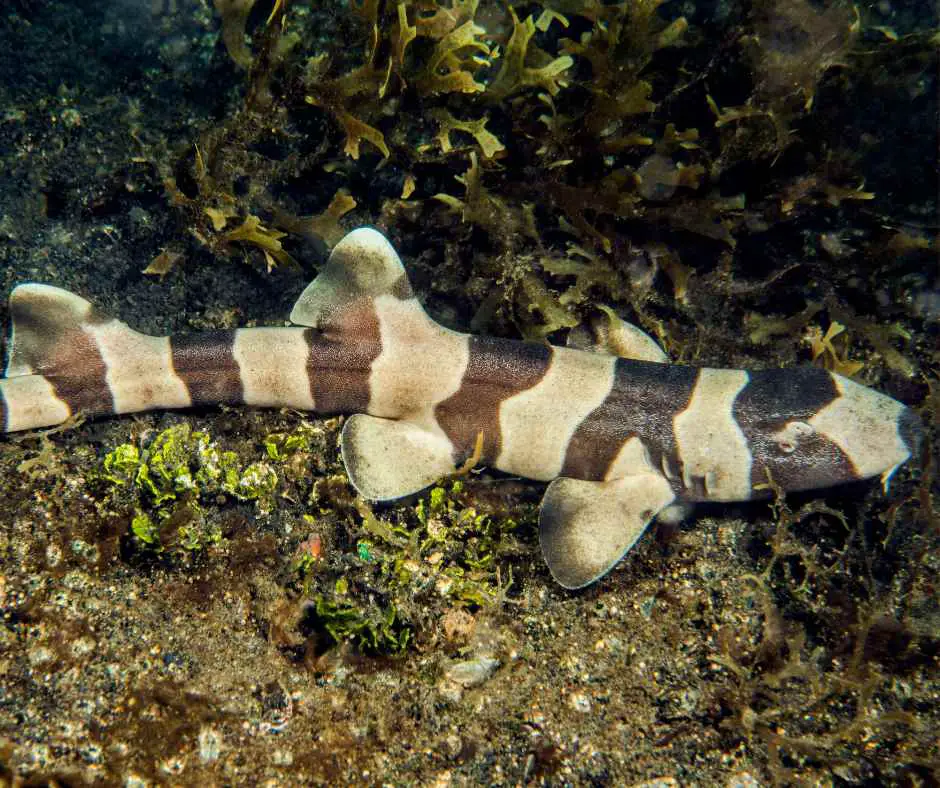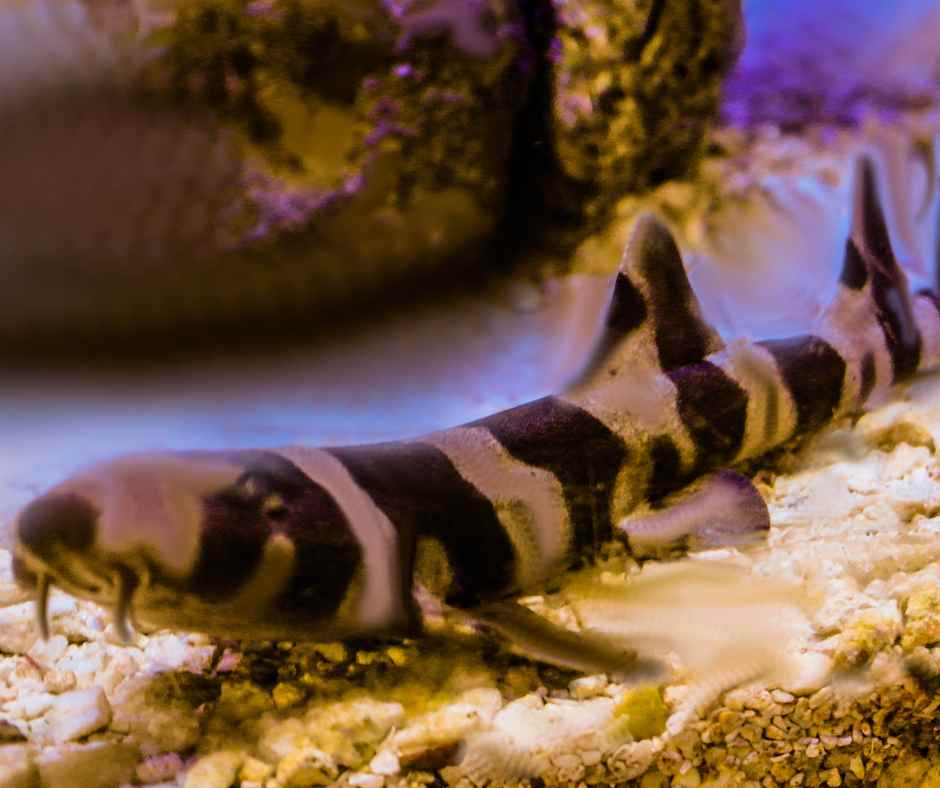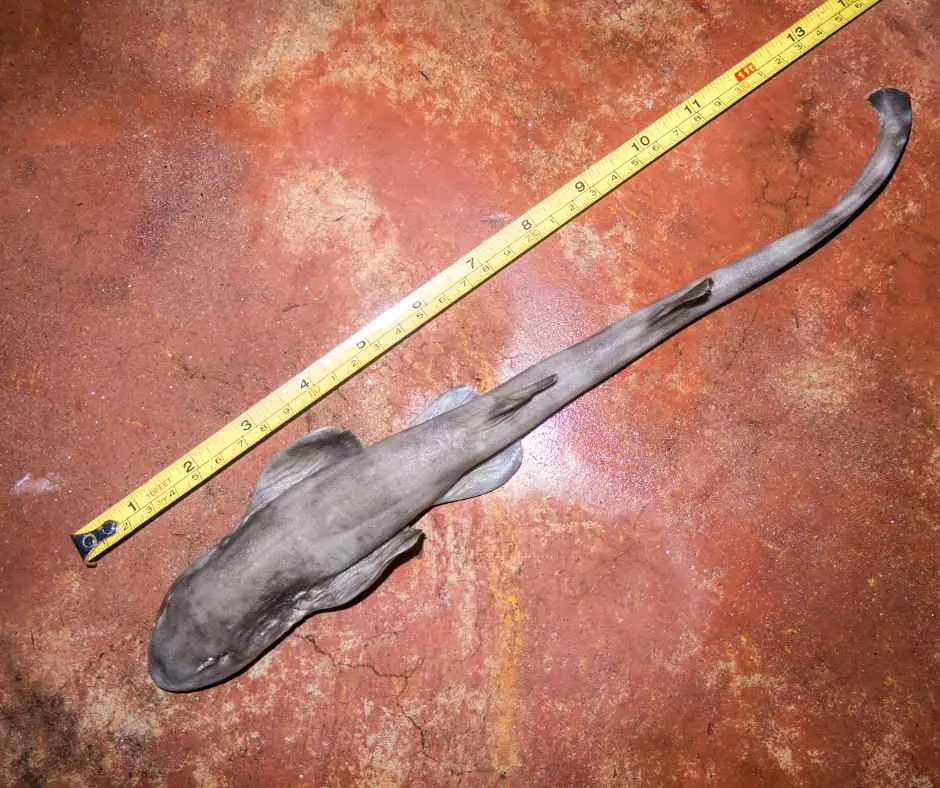Bamboo Sharks are considered one of the most popular pet sharks in the world. These sharks live in the shallow waters of the Indo-Pacific. Bamboo Sharks have long tails that are longer than their entire remaining body.

These sharks are also known as ‘cat sharks’ because the nasal barbels near their mouths look like cat whiskers. Spectators use another word for these sharks based on their appearance. Due to their carpet-like appearance, they are called ‘Longtail Carpet Sharks’.
Where are Bamboo Sharks Found?
Bamboo sharks are found in various parts of the planet, making them a popular type of shark. However, we will talk about the living conditions of Bamboo sharks in detail.
Geographical Locations of Bamboo Sharks
Bamboo sharks inhabit the Indo-Pacific region, specifically the shallow waters off the coasts of India, Southeast Asia, and the western Pacific Ocean. These species have been observed in the waters surrounding the Philippines, Indonesia, and Papua New Guinea islands.
Habitat of Bamboo Sharks
These sharks love to live in shallow waters near coral reefs. Additionally, they live around rocky outcroppings, which can be incredible hiding places. Furthermore, these sharks love to stay in areas with sandy bottoms. These environments are ideal for the desired living conditions of bamboo sharks.
Biology of Bamboo Sharks
These sharks are oviparous. It means that they lay eggs rather than give birth. The female bamboo sharks lay an egg case, which the male bamboo shark fertilizes. The egg case acts as a protection for the developing shark, and it often attaches to rocks and coral reefs. It takes about 6-10 weeks for the bamboo shark eggs to hatch. Young sharks can swim and hunt prey on their own when needed. The approximate life of a bamboo shark is 20 years in the wild.
Conservation Status of Bamboo Sharks
Bamboo sharks are not considered endangered but are occasionally caught and traded as part of the aquarium trade. Individuals removed from the wild and placed in captivity, where they may not have access to the food and habitat they require to survive, can have a negative impact on local populations.
Furthermore, the destruction of coral reefs and other underwater habitats due to human activities such as pollution and overfishing can negatively impact these species’ populations.
Physical Characteristics of Bamboo Sharks
Bamboo sharks are small in size, with an average length of 3-4 feet and a weight of 10-15 pounds. They have a distinct, flattened shape that allows them to navigate through tight spaces and across the ocean floor easily. Their bodies are also covered in rough, sandpaper-like skin, which aids in movement over the substrate and avoiding predators.
Color of Bamboo Sharks
Bamboo sharks have a distinct, mottled coloration that allows them to blend in with their surroundings. They are typically brownish-grey in color with darker markings and spots that help them blend in with the rocky and sandy environments in which they live.
Fins and Tail of Bamboo Sharks
Bamboo sharks have large, triangular pectoral fins and a broad, flat tail that helps them swim efficiently. They also have small, rounded dorsal and anal fins that help them balance and move properly.
Eyes and Nostrils of Bamboo Sharks
These sharks have large and sensitive eyes. However, these eyes adapt well to low-light conditions. The Bamboo sharks have sensitive nostrils that they use to detect food and other underwater scents.
Types of Bamboo Sharks
There are various types of Bamboo Sharks found all over the world. However, the following are the most common types of Bamboo Sharks:
Brown banded Bamboo Sharks
These sharks are native to the Indo-Pacific region and are known for their distinctive brown and white striped pattern. Due to their docile nature, they are one of the most compatible sharks for captivity. In addition, they love eating crustaceans and small fish.
Epaulette Sharks
This shark is a species hailing from the Hemiscylliidae family. These sharks were given this name due to the large, white-margined black spot behind their pectoral fins. These spots are similar to military epaulettes; they are called epaulette sharks. They are typically in shallow, tropical waters off Australia and New Guinea.
Speckled Carpet Shark
It is a bamboo shark that lives in North and West Australia. The shark loves to live in shallow coral reefs. Australia is the home of coral reefs, so most sharks are found there. However, some speckled carpet sharks are seen in Indonesia too. These sharks primarily feed on small crustaceans and bony fish.
White spotted Bamboo Shark

Little-known inshore sharks typically live on the rocks and coral reefs. These sharks primarily feed on crustaceans and fish.
Burmese Bamboo Shark
Burmese Bamboo shark is a type of shark that is typically found in Burma. It is an extremely rare shark.
Dietary Habits of Bamboo Sharks
Bamboo sharks feed on numerous prey items in their natural habitat. some of these organisms include crustaceans, mollusks, and small fish. These sharks are opportunistic feeders of a kind; thus, they may consume anything small that might feel suitable for them to prey on. But, bamboo sharks eat different things depending on what they can find in their environment.
Shark’s Diet in Fish Tanks
The shark’s diet changes slightly when you capture a shark in a fish tank or aquarium. You can feed your bamboo shark a fresh seafood and frozen shrimp diet. You can also feed live food to your shark as it can provide extra stimulation to the shark.
How to Feed a Captive Bamboo Shark?
You need to remember the feeding frequency of a Bamboo shark if you adopt them. They are nocturnal; hence they are fed during the night. Additionally, feed these sharks only once or twice a week. However, you can overfeed them if they have big sizes.
Unless a vet or a shark expert does not recommend you, refrain from overfeeding a shark. Unnecessary overfeeding a shark can create countless health problems for the bamboo shark.
Provide a Balanced Diet
You must provide a balanced diet to your captivated Bamboo Shark. It is crucial to take care of the shark’s health. The overall health and well-being of sharks must be taken seriously. Otherwise, it can cause complications for the shark.
A diet that does not contain the required nutrients may result in stunted growth, a weakened immune system, and various other issues for the shark.
Lesser Known Facts about Bamboo Sharks
- Bamboo sharks belong to the family Hemiscylliidae, so they are not related to true sharks.
- These sharks are slow-moving creatures; hence they do not behave aggressively with humans.
- The sharks have compressed bodies that enable them to navigate tight spaces for food.
- They possess an extremely effective sense of smell. They can detect food and potential mate from a distance through their impeccable smelling quality.
- They are one of the best shark species to pet at home.
- These sharks have low production rates, making them vulnerable to low population issues.
- Some species of Bamboo sharks may exhibit unusual behavior if not treated right.
- Bamboo sharks have a social personality. It means that they love to form groups and interact with each other.
Threats to Bamboo Sharks
Bamboo Sharks face numerous threats that have resulted in poor living conditions. Thousands of Bamboo sharks have died as a direct or indirect result of these activities. The biggest threats to the bamboo sharks are listed below:
- Overfishing
The most challenging issue for Bamboo Sharks is overfishing. Fishermen destroy the habitats of these sharks and capture them. Even though scientists have advised countries to ban fishing sharks, many countries still have no strict policies against fishing.
- Pollution
Water pollution has also played a vital role in destroying the lives of Bamboo sharks. Nothing remains safe from pollution and waste being spread by human beings.
- Hunting
Hunting is also one of the biggest threats to Bamboo Sharks. Hunters hunt sharks for various reasons. They do this to create products such as leather and other industrial products.
Bamboo Shark Size

The size of Bamboo Sharks may vary from specie to specie. The majority of bamboo sharks are medium-sized. However, some are bigger than necessary, while others are smaller.
Here are the sizes of various types of Bamboo sharks.
Brown banded Bamboo Shark Size
The maximum length of these sharks is around 1.0 meter (3.3ft). The size of a young Brow banded Bamboo shark may be smaller than this.
White spotted Bamboo Shark Size
The maximum length of a Whitespotted Bamboo shark is 1.2 m (3.9 ft). These Bamboo sharks are slightly bigger than the ones previously mentioned.
Epaulette Shark Size
The maximum length of Epaulette sharks is around 1.0 m. their size is approximately the same as Brown banded sharks.
Blac barred Sharks Size
They also have a similar length of around 1 m.
Horn Shark Size
They are one of the biggest species of Bamboo Sharks. They can grow up to 1.3 m (4.3 ft).
Tips for Petting a Bamboo Shark in a Tank
The following are some essential tips if you are interested in petting a Bamboo shark in a tank:
- Maintain a temperature range between 72-78 degrees F in the tank.
- Perform regular water changes to maintain the water quality of the tank.
- Place sand at the end of the tank, as bamboo sharks are bottom-dwellers.
- Provide ample space for the bamboo shark to swim.
- Do not handle the shark excessively. It will increase the chances of injuries.
- Wash your hands before and after handling the shark to prevent bacterial infections.
- Use rounded edges for the shark tank.
- Create hiding spaces in the tank. Ensure that these spaces are not too small; otherwise, the shark can get trapped.
Bamboo Shark Tank Size
The size of the tank depends on the Bamboo shark’s size. The smallest bamboo sharks have relatively different tank size requirements as compared to the biggest bamboo sharks. Therefore, here are the bamboo shark tank sizes for sharks of different sizes:
Baby Bamboo Shark’s Tank Requirements
Since a baby Bamboo shark is small in size, it can fit in a small shark tank. For a baby bamboo shark, you can use a tank between 55-75 gallons. Otherwise, you can also opt for a bigger tank.
Brown banded Bamboo Shark’s Tank Requirements
These sharks are relatively challenging to care for compared to other Bamboo Sharks. Therefore, we only recommend petting them if you are an expert. In addition, these sharks need a minimum of 180 gallons if you want to pet them.
We do not recommend smaller tanks for Brown-banded Bamboo Sharks because they increase in size quickly. To keep things easier for you and your pets, you must use a 200-gallon fish tank for them. That way, you will also be able to accommodate other smaller fish species.
White spotted Bamboo Sharks Requirements
The male white-spotted Bamboo Sharks have bigger sizes than the female ones. In addition, they have black spots all around their bodies. Their size and adaptable nature make them a popular choice in public aquariums.
The white-spotted Bamboo Sharks’ requirements are similar to the other types of Bamboo Sharks. The minimum size required for a white-spotted bamboo shark is 180 gallons. However, they are relatively minor than the other two Bamboo Sharks. Hence, you can fit it into a slightly smaller fish tank.
Conclusion
Bamboo Sharks remain a popular choice for people who want to pet sharks. These sharks typically love living inside oceans, but you can also provide a good environment for them in captivity.
If you plan to pet a Bamboo shark, ensure that you are willing to provide the required facilities to the shark. Also, keep in mind that petting sharks can be an expensive hobby. Therefore, think before adopting sharks.
These unique creatures can be entertaining pets for veteran aquarists. However, you must remember that they are not suitable for everyone. Maintaining the correct water temperature and providing a perfect fish tank are mandatory for petting a bamboo shark. Just a little carelessness can cause many complications for you and the shark.
Furthermore, these sharks need a balanced diet for proper growth. Underfeeding and overfeeding the shark are equally dangerous for the shark’s health. Therefore, maintaining a balance between the shark’s diet should be the top priority. Although, bamboo sharks might not be as interactive as other pets, but they are equally entertaining.
Overall, conduct research on these sharks before petting them. You must know the details and requirements of the particular bamboo shark you are interested in petting. You can still learn more about these intriguing shark species if you do not want to pet them.
